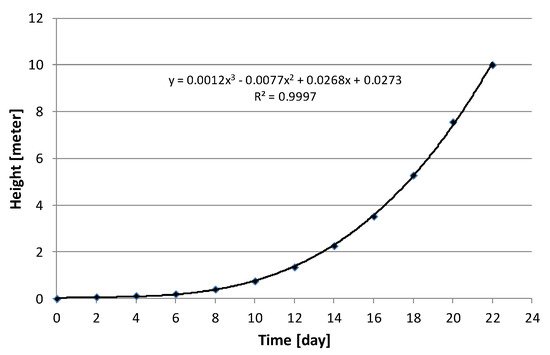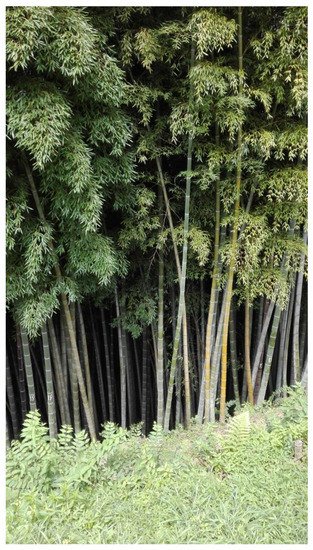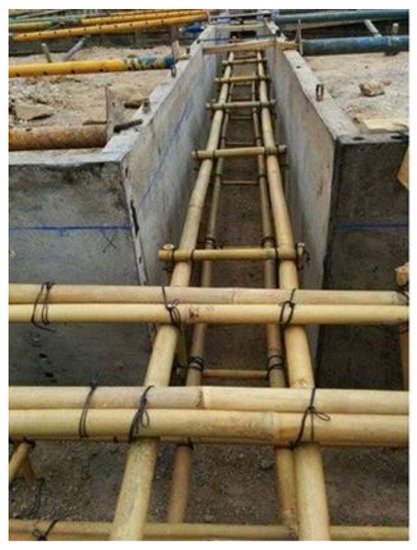From the different materials available, bamboo—a group of perennial grass with large woody culm encompassing 1662 species with 121 genera—has increasingly attracted attention as an interesting material, including single bamboo fibres and bamboo strips, to replace conventional construction and other materials
[1]. Bamboo products have been suggested as having a significant positive environmental impact and distinctive social and economic benefits
[2] by calling for innovative approaches to using natural materials, triggering eco-innovation, and promoting the circular economy
[3]. The use of bamboo requires creativity and reopening to natural materials, which have been proposed as foundational to the economy of the future as they reflect the changes taking place due to innovative ideas and solutions as well as successive industrial evolution and technological progress
[4][5].
Expanding the diverse use of bamboo as an ecological material makes sense because more than 1000 varieties of bamboo are distributed around the world in tropical, subtropical, and temperate regions
[6]. Additionally, the bamboo growth cycle (3~5 years) is significantly shorter than that of wood, its carbon capture ability is three-fold better compared to other plants (3.73 cubic meter of CO
2)
[7], and it possess outstanding mechanical properties. For example, bamboo’s tensile strength is 370 MPa and its elastic modulus is 20,000 MPa, comparable or higher than the values reported for some types of steel, wood, or concrete
[8].
As the world looks for ecological solutions, bamboo is one of the most economical forest species, with new uses found every few years. Just to mention one example, recent antibacterial and UV absorption bamboo clothing was created using a characteristic of lignin in bamboo fibre
[7]. Nowadays, bamboo plays a key role in economic development, and it certainly can cover a wide range of human needs, from environmental protection to use in home appliances.
As defined by the Sustainable Development Goals (SDGs) proposed by the United Nations, promoting and supporting actions towards sustainable development, including product design, development, and withdrawal, will help to enhance product life cycle
[9] and simultaneously increase efficiency, competitiveness, and innovation
[10].
2.1. Bamboo Plant Characteristics
Bamboo is perennial, green year-round, and part of the grass family plant. Like grass, bamboo is characterized by a jointed stem called a culm. Typically, culms are blanked, but some bamboo species have solid culms
[11]. The splitting force along the grain of the bamboo internode is low; however, thanks to the existence of nodes, interlayer propagation becomes more difficult
[12]. There are several different characteristics (e.g., strength, smoothness, straightness, lightness, hardness, and hollowness of culms, the regularity and facility with which they split, and different lengths, sizes, and thicknesses of their joints) that make bamboo suitable for numerous “end products” and different purposes. Each culm segment begins and ends with a reliable joint called the node. Bamboo nodes have a positive effect on properties, increasing their strength
[13]. Nodes are typified by a bulging encircling the ends of the culm segments. Bamboo biomass increases 10% to 30% per year, significantly more than the biomass increase for trees (2–5%), which suggests a preferable performance of the raw material for use. Almost every species of bamboo spreads very quickly and possesses an aggressive root system in the form of rhizomes spreading in the soil. In addition, many bamboo varieties are cold-resistant and capable of growth under freezing conditions (minus 15–20 °C); for these reasons, bamboo species occupy over 50 million hectares of land
[14][15]. Because of its fast growth cycle (
Figure 1), cultivation of bamboo is considered an interesting climate change mitigation strategy.
Figure 1. Dynamic of bamboo growth. Source: own elaboration based on
[16].
Bamboo growth dynamics are very interesting, as the plant is characterized by fast longitudinal growth within the second and third weeks. In its first growth phase (i.e., the first 12 days), daily length increase has been estimated up to 6 cm; after that, growth dynamics increase rapidly and during the next 4 days bamboo grows 37 cm. During the third week, bamboo can grow up to 80 cm per day. Due to these properties, bamboo absorbs large amounts of CO
2. Simulations conducted on bamboo cultivation show that if 10 million hectares of additional bamboo were planted in a total of 30 years, bamboo plants and products could save over 7 gigatons of CO
2 [16].
2.2. Current Bamboo Applications
Bamboo has been known and used for different applications since ancient times, but it has largely been forgotten for decades in the past. Nowadays, however, the benefits of bamboo have been revisited and argued for scientifically once again. Bamboo has become widely used for a broad range of purposes after the intensification of research on it during the 1980s, which significantly contributed to understanding the importance of woody grasses and thus to an increase in and improvement of bamboo processing for wider use
[17]. Although several solutions have been implemented and scientific papers published, bamboo research remains fresh and worth considering. Bamboo research has attracted significant interest; available studies include a wide variety of topics from bamboo’s anatomy
[18] through its use in products of daily life, in building, or for the fabrication of musical instruments
[19][20].
The abundance of bamboo as a valuable resource in some regions requires prospects for further research. Its market and the influence of different factors (e.g., trade problems, high fuel costs, currency rate changes) on bamboo production have been described in the past
[21][22]. In traditional, time-honoured products such as handicrafts, blinds, and bamboo shoots, demand remains strong, with sustained earning potential despite moderate growth. Other traditional and widely used products such as chopsticks are highly commodity-traded and have commercial value but low growth and profit margins.
Young bamboo shoots contain up to 90% water and are rich in vitamins, cellulose, and amino acids. Bamboo contains from 2–6% starch, 2% deoxidized saccharide, 2–4% fat, and 0.8–6% protein. It has also been reported to have a high nutritional value, low fat content, and as being rich in valuable fibre. Bamboo shoots are sold fresh in bazaars and markets and are exported all over the world preserved in brine, representing a multi-million-dollar trade commodity
[23]. Because of its numerous varieties, which also allow for the acquisition of material with different properties, bamboo has potential as a bioenergy crop, but also as a material for niche markets. Despite some studies in which the high yield of bamboo seems exaggerated, bamboo is still not widely discussed in terms of productivity and industrial applications; most reports have come from Asia in the last 15–20 years, where bamboo has expanded as a superior substitute for wood. The significant role of bamboo in industrial production and environmental protection, however, requires more comprehensive research and statistics on bamboo resources, as well as an estimation of its use in international trade
[24]. This lack of information is identified as a significant knowledge gap worth attention.
2.3. Bamboo for Environmental Protection
Bamboo grows very easy in different climate conditions and altitudes
[25], which allows it to help to increase forest resource volumes
[26] and reduce the pressure of timber consumption from natural forests as substitute products for wood
[27][28]. Bamboo forests possess great potential for carbon sequestration, and they are the most likely type of forest to enter the emission reduction market
[29]. Several studies have reported the role of bamboo forests in global carbon cycling
[16][30] as well as their successful use in absorbing wastewater from agriculture, industry, animal husbandry, and pollution. Bamboo is particularly useful in terms of air protection as a good material for carbon sequestration. The CO
2-absorbing properties of bamboo have been studied in the past mainly in areas where bamboo naturally forms wild forests. Bamboo forests play a leading role in regional and global carbon (C) cycles and carbon sink
[31][32]. Bamboo can absorb up to 12 tons of CO
2 per hectare per year, stabilizing the gas content in the atmosphere and releasing 30% more oxygen than other plants
[33]. Therefore, bamboo can be considered as reducing negative effects of climate change as a large carbon sink in nature, playing a key role in adapting and improving human ecosystems.
Figure 2 shows bamboo forests in Batumi (Georgia), which absorb carbon dioxide from the atmosphere and thereby contribute to the improvement of the air condition.
Figure 2. Bamboo (Phyllostachys pubescens Moso Bamboo) forest in Batumi (Georgia, Caucasus).
These estimates suggest that growing bamboo on 10 million hectares is equivalent to saving primary energy consumption for more than 300 million new electric cars. This statistic does not include the emissions saved by replacing aluminium, concrete, plastic, or steel with bamboo. The replacement of traditional building materials can therefore contribute to a positive environmental and climate change impact.
2.4. Bamboo as Material in the Construction Sector
Bamboo is characterized by high strength and flexibility, which makes it an ideal building and construction material in Africa, Asia, and Latin America. Bamboo, because of its microfiber structures containing lignin and hemicellulose (lignin–carbohydrate complex (LCC)), has a greater strength than concrete and steel by weight, and this strength is due to the thickness of the fibre in the sclerenchyma tissue
[34]. The tensile strength of bamboo (
Table 1) is greater than that of mild steel, and it can withstand compression twice as well as concrete, easily replacing materials stuck in road construction, drainage pipes, housing, and wind turbine construction
[25]. The tensile strength of bamboo is 160 N/mm
2, three times stronger than most types of constructional timber used in industry
[16]. The compressive strength is 40–80 N/mm
2, two to four times the value of most timber species. Bending strength is 50–150 N/mm
2, twice strong as convectional structural timbers. Bamboo material can be used for almost all elements of construction and home furnishing, including poles supporting ceilings or roofs, or as elements of walls and floors. Bamboo may be substituted for wood in many industrial adhibitions and thereupon contribute to the restoration and saving of the world’s forests. For example, in architecture, panels and boards made of bamboo are characterized by high hardness and are abrasion-resistant; they are also classified as durable materials and able to replace more expensive hardwood products. Bamboo can also be used as beams and trusses. Adding bamboo to cement has been reported as strengthening concrete structures, with great potential for the mass construction of inexpensive dwellings or as an excellent material for building structures with great resiliency to earthquakes and landslides
[35].
Table 1. Comparison of selected mechanical properties of spruce wood, steel, and bamboo. Source: own elaboration based on
[36][37][38][39].
| Properties [kN/cm2] |
Spruce Wood |
Steel |
Bamboo |
| Modulus of elasticity |
1100 |
21,000 |
2000 |
| Modulus of rupture |
7.2 |
20.0 |
12.1–20.9 |
| Compressive strength |
4.3 |
14.0 |
6.2–9.5 |
| Tension strength |
8.9 |
16.0 |
14.8–38.4 |
| Bending strength |
6.8 |
14.0 |
7.6–27.6 |
| Shear strength |
0.7 |
9.2 |
2.0 |
The construction industry faces major concerns about their associated carbon emissions, which are considered responsible for 7% of global CO
2 emissions. Therefore, the need to explore alternative building materials that will reduce the overall amount of CO
2 emissions is a pressing and stimulating research topic on alternative building materials
[40]. Solutions that can be considered innovative are more and more often sought. The search for solutions related to alternative materials has turned attention toward bamboo as a reinforcing material. Organic waste (e.g., bamboo leaves or a mixture of straw) can be used, after thermal activation, during cement production and have been identified as a cheap alternative to the production of composites reinforced with natural fibres and as significantly improving the mechanical properties
[41].
The values of the mechanical properties for bamboo presented in Table 1 are given in numerical intervals, because their value depends on the diameter of the culm and the wall thickness of the tested material sample.
Due to the presented properties in the Table 1, bamboo is widely used in construction. Figure 3 and Figure 4 show examples of bamboo serving as a pole supporting the ceiling and elements in strengthening the foundations.
Figure 3. Ceiling support (Batumi 2019).
Figure 4. Bamboo in replacement for steel reinforcement.
Burning bamboo produces ash with potential applications in construction. Dry bamboo ash is used as a concrete additive to make cubes, cylinders, and beams. The addition of bamboo ash increases the compression module of concrete cubes, the tensile module of concrete cylinders, and the bending strength module of concrete beams
[42]. The addition of bamboo ash improves concrete’s strength and shortens setting time, improves consistency, compaction factor, precipitation, and water absorption. Therefore, adding bamboo ash saves construction costs and improves concrete’s properties
[43].
2.5. Bamboo for Energy Production
Bamboo has been suggested as having potential as a bioenergy material. It is characterized by several worthy fuel characteristics with certain other bioenergy substances, such as a low ash content and alkali index. The main components of bamboo culms are lignin, cellulose, and hemi-cellulose, amounting for over 90% of the total mass. The minor constituents of bamboo are resins, tannins, waxes, and inorganic salts. Compared to wood, bamboo has a higher content of alkaline extracts, ash, and silica
[27]. The major ash-forming constituents from bamboo are potassium (K
2O) and silica (SiO
2). It also contains chlorine (Cl), calcium (CaO), and magnesium (MgO). To evaluate the quality of biofuels, it is essential to have knowledge of the contents of chlorine (Cl) and sulphur (S). A high amount of these elements provokes corrosion and contamination of boilers, pipes, and guide wires and increases emissions of SOx, Cl
2, and HCl
[44]. Due to its specific chemical composition, bamboo is resistant to attacks from fungi, mould, and borers
[45].
Because the plant’s quality is improved by cutting and harvesting, bamboo can be re-harvested in three-year cycles without any noxious upshot on the environment. Ifthe researchers compare the average length of the lifespan of sequoia, which is about 500 years compared with the lifespan of bamboo, it is easily visible that it is much longer than that of bamboo, so thatthe researchers can see that bamboo can be harvested and cultivated for over 150 times
[44]. Energy produced from bamboo biomass has great potential to become an alternative to traditional fossil fuel. Bamboo biomass is obtained from the entire plant and comes from the stems, the culms, and the branches and leaves. Bamboo biomass can be converted in many ways (e.g., through biochemical or thermal conversion) to produce various energy products (e.g., syngas and biofuels or charcoal) which can become substitutes for subsisting fossil fuel products. Bamboo biomass alone, however, is not able to meet and satisfy global energy demand. It needs to be combined with other sources to best exploit its potential and provide a sustainable energy supply
[45]. The research conducted shows that bamboo biomass has a relatively higher calorific value than other sorts of biomass plants, which means that it is a good material for direct combustion (e.g., co-combustion in a thermal power plant). Many different projects concerning bamboo energy are functioning, operating, or being implemented all over the world. In African countries, bamboo biomass projects are very popular, and bamboo there is most likely to be used as a substitute for firewood or charcoal in domestic use. One possible method of converting biomass into biofuel is through the hydrothermal carbonization process, also known as hydrothermal carbonization (HTC). However, it should be noted that the calorific value of bamboo is higher than that of most agricultural waste, but lower than that of most wood products. However, the HTC process offers the possibility of increasing the energy density of bamboo using an essentially exothermic and relatively simple process. Bamboo, thanks to its features and properties, is an interesting and suitable material of plant origin to produce biochar
[46].
Another possibility for using bamboo biomass is biochar, as mentioned above. Biochar from raw bamboo biomass can be effectively used for securing anionic radioactive pollutants. Positive use of bamboo biochar was noted during its use at elevated concentrations of Tc in the environment, which occurred accidentally during leaks from a nuclear facility. Biochar represents a possibility of TcO
4− separation
[47]. Currently, research is also being carried out on biocarbon, which, using natural additives, is a promising tool for immobilizing and neutralizing various pollutants in liquid waste, water solutions, and soils. By using bamboo as a biomass raw material, the sorption properties can be further improved. Biochar with the addition of bamboo biomass was produced and synthesized as a biochar/montmorillonite composite in an experimental pyrolysis reactor. The bamboo-based biochar/montmorillonite composite can be effectively used in sewage treatment plants where the treatment of industrial wastewater or wastewater-containing anionic pollutants, such as nitrates, is carried out
[48].
2.6. Bamboo as an Additive for Biodegradable Products
Research conducted with biodegradable materials suggests that the addition of substrates (e.g., bamboo, pine dust) changes the mechanical and chemical properties of biodegradable materials
[49]. Bamboo is fast replacing plastic and other production materials. For example, plates and cups are produced from bamboo–plastic composites, popularly known as BPCs. BPCs consist of bamboo fibres mixed with epoxy resins which are biodegradable depending on the type of polymers and other chemicals used in their production
[50]. Bamboo additives have been also used for packaging films for food. Biocomposite films are prepared using bamboo fibre to reinforce other modified and unmodified natural materials, resulting in improved mechanical characteristics. Experimental results have demonstrated the high potential of renewable and biodegradable biopolymer composite films in the food industry
[51]. Biocomposite samples have been technologically reinforced with raw bamboo fibre and then processed, showing increased biodegradability and weight reduction after 30 days of analyses. Generally, the biodegradability studies have indicated that crude bamboo fibre in biocomposites strengthened the activity and effects of microorganisms due to the higher lignin and hemicellulose contents
[52].
Furthermore, bamboo products have adequate hydrophilicity and permeability. Bamboo-related textile products are characterized by a soft touch, excellent colour, and antibacterial and anti-allergic properties. Other important features are that bamboo fibre is UV protective, biodegradable, naturally anti-bacterial, breathable cool, strong flexible, soft, and of a luxurious shiny appearance
[53]. Bamboo fibre, thanks to its properties, very quickly and effectively absorbs and facilitates the evaporation of sweat and moisture. Its ultimate respiration ability keeps the exploiter convenient and dry for a much longer period. For creators in the textile industry belonging to a creative industry, bamboo material is perfect for creating new designs that meet fashion expectations.
Figure 5 shows bamboo textile products. Due to its properties, bamboo can be used as excellent textile material.
Figure 5. Bamboo socks in a Turkish shop (Artvin 2019).
2.7. Bamboo in Gardening and Architecture
Bamboo is an excellent material for the construction of different elements and structures in gardens and zoos, as shown at the Figure 6 and Figure 7 respectively.
Figure 6. Bamboo gazebo in a garden in Batumi (2019).
Figure 7. Bamboo elements in enclosure for animals (Batumi 2019).
The main advantages of using bamboo in zoos include sourcing rapidly renewable products, easy replacement during construction or reconstruction of new animal exhibits, and also the provision of a sense of security to animals and help in protecting wildlife habitat. The use of sustainable building materials like bamboo reduces negative environmental impacts such as the deforestation of green areas and other negative and/or destructive practices. Several bamboo products, including sanitary sticks, bamboo brooms, and bamboo fans, have become a daily need for a wide range of people
[54]. Bamboo timbers are luxury woody materials widely used in furniture and flooring
[7]; they are also the most suitable materials for building development and bridge construction due to their microstructural and mechanical strength
[55].












